Cecilia Wright
Opera singer, vaudeville entertainer, sports reporter, aviatrix and adopted daughter of the US Navy.
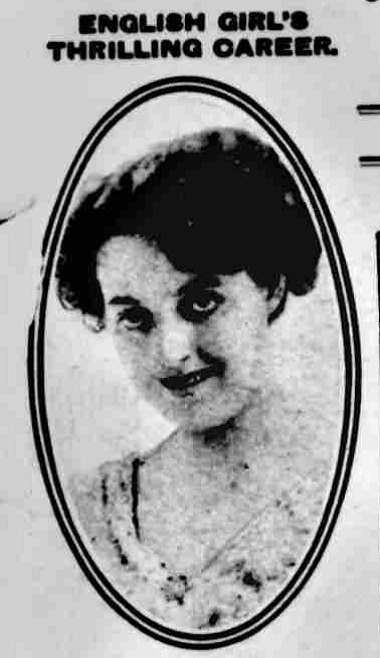
‘Her parents reside at the famous Lancashire holiday resort of Blackpool.’… ‘She has had a varied and most romantic career in the States, where she has won fame in many roles, including that of a beauty, an aviator, a journalist and a vocalist. She is known as the adopted daughter of the American navy.’
Introduction
While researching the life of Cecilia Loftus, vaudeville artiste and famed mimic, who had an education at Layton convent in Blackpool, another Cecilia with a Blackpool connection popped up occasionally in the search results of the newspapers. As an adopted daughter of the US navy she was described as being a Blackpool ‘girl’. Female indeed she was but ‘girl’ is a somewhat patronising term to use today. And then she wasn’t born in Blackpool but in Whittingham near Preston and that town would want to legitimately claim her as a Preston ‘girl’, too. From her worldwide tours and her eventual residency in America, she would return on a rare occasion to Blackpool to where her mother and father had moved on their retirement.
As well as being in Gilbert and Sullivan as a prima donna and, as a vaudeville artiste, loved on the other side of the Atlantic more than this side (UK), she had shaken the hand, and sung before the American president Woodrow Wilson and had been dined by him and senior officers and received letters of appreciation from the mayors of nearly every city or town she had visited in the USA. She was a much travelled person and even achieved a record height in an aeroplane by a woman. She became a sports correspondent and reported on the controversial Jack Johnson-Jess Willard fight in 1915, the first ever female boxing reporter of world heavyweight fight. But otherwise there is not much known about her. She achieves fame in the second decade of the 20th century riding the patriotic airwaves of the Requiem for the sailors of the USS Maine and slips into obscurity by the third decade and her death, to date, is not yet established.
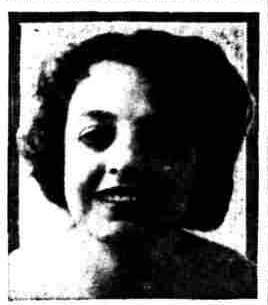
As far as her connection to Blackpool goes, her parents have two Blackpool addresses, one being 23 Braithwaite Street on the 1911 census return and as reported in the newspapers of 1914 and another being No 5 Belgrave Road in 1917, similarly referred to in the newspapers. Cecilia, as a celebrity, warranted a report as visiting at least one of these addresses. Another newspaper article gives her father’s status as formerly employed at Whittingham hospital. I used to pass this hospital on my way to and from the site at Ribchester where I worked as an archaeologist some years before its demolition and a couple of ex classmates worked there too, with stories to tell. As a psychiatric hospital it had a sad demise when it was found that its inmates had been systematically cruelly treated and its Victorian design had perhaps outlived a more modern understanding of mental illnesses. Indeed as early as 1878, and quite coincidentally, a William Wright was found to have been mishandled at the hospital by the evidence of cuts and bruises to his body after having been discharged as a patient from there.
William Wright was the name of Cecilia’s father and the census returns for Preston show that he was from Besthorpe in Norfolk originally, and that he was employed as a ‘lunatic attendant’, eventually being promoted to ‘chief lunatic attendant’. And it was where Cecilia and her brother Charles Leonard, were born, and they were baptised in the nearby church at Goosnargh. Cecilia was baptised on 21st January 1886 (though a transcription of the parish records states 21st February), and Charles on 27 August 1893. The family are still at Whittingham in 1901 and then reappear in Blackpool in 1911 where Charles is still at home and strangely described as ‘at school’, aged 17. He later went to work at Whittingham Hospital so possibly and speculatively he may have been in training. Cecilia, not found on the census returns at this date, is probably away with a touring group or unidentified and in London and playing Gilbert and Sullivan.
Cecilia’s mother’s pre-married name is Cragg and there is an Alice Cragg as an attendant at the hospital in 1871, and it can be confidently assumed that Alice and William met at the hospital and they were married in 1883 at Goosnargh (Lancashire parish records). Alice was born in Lancaster. There is a Mary Cragg also born in Lancaster and working at the hospital, too and who may have been a sister to Alice.
Their daughter Cecilia had an interest in music, and an ability and confidence to sing, from an early age and went on to make a big success in a village concert when she was eight years old. In her teens she became choir mistress and organist at the Whittingham Hospital where her father worked and where she was resident, and by now she had entered the classes of Madame Margaret Milward at the Bromsgrove Institute in the Midlands. In November 1903 she performed ‘very charmingly’ at the Royal Society of Artists there as a vocalist. And in December of the same year she had, still under the tutelage of Madame Milward, achieved a Grade 4 certificate in the local practical examinations of the Incorporated Society of Musicians. A little later in the following year in February, she entered into a musical singing competition at the Public Hall in Preston. Billed from Whittingham, she was successfully selected as a finalist with her contralto voice, but there is no report of the final taking place.
In the January of 1904, at 18 years of age, she gave what might be one of her first concerts, and sang as soprano, at the Institute. Reviews were mixed but, with evident talent nevertheless, her weaknesses in some of her songs were apparent but also her strength in others was praised. Thus the commentators were ‘rather disappointed in Miss Wright in the commencement of her works’ but put it down to nervousness and were pleased with her other renditions and she sang at her best when accompanied by her teacher Madame Milward herself. These concerts which contained elements of vaudeville within them were advertised in the Bromsgove Messenger.
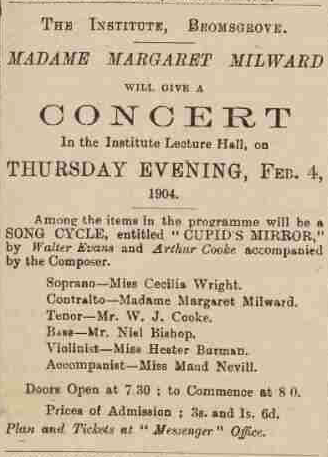
While her teacher Margaret Milward received great accolade, her 18 year old pupil Cecilia Wright appeared somewhat nervous but there was very definitely an excellent singing voice in her as she gained in confidence especially when he was accompanied by Madame Milward herself. Admission prices for the event would be equivalent to 15p and 7½p or £7 or £3.50 approx in 2022.
From then on she entered the stage as in retrospective reports she had performed, and achieved great success in prima donna roles in Gilbert and Sullivan in London at the Savoy, especially as Elsie Maynard in Yeomen of the Guard in which a soprano voice would be required, though there are no contemporary reports or reviews located to date of the performances. It seems that she was an important member of a company but never achieved superstar status in that area throughout he career on the stage. But we next hear of her in Cuba in 1912 where she had either gone to visit friends or was touring as part of a theatrical troupe depending upon which report is the accurate one.
It was a significant time for her in Cuba and she had eventually acquired the middle name of Manuela and then she was lured into vaudeville where at Keith’s in New York we learn that she makes her debut, with the added weight to her billing as being the adopted daughter of the US Navy. She had earned this title for her voluntary singing at the Requiem for the dead of the battleship USS Maine in Havana on 16th March 1912. Coincidentally the event was to take place at exactly the same date that Cecilia was on the island. The sinking of the battleship Maine had occurred in 1898 when on a visit, ostensibly friendly, it was blown up and sank with the loss of 266 lives. Tensions between the Cubans and their Spanish rulers had been strong for some time beforehand and the explosion on the battleship was blamed on a mine planted by the Spanish and which sparked off a war between the US and Spain. Lasting only a few months, the US gained the victory and a Treaty was concluded in December in Paris the same year giving Cuba its independence from Spain and the US acquired Spanish possessions in the Americas and the Far East.
One report stated that she was visiting friends and another that she was on tour with an ‘important touring engagement’ which could have referred to light opera or even specifically to Gilbert and Sullivan. Already confident in voice, she volunteered to sing the Requiem for the dead sailors at the military service, and having been accepted as the lead singer, endeared herself to the living sailors of the navy there and then. This took place at Fort Cabana overlooking the harbour in the morning before the afternoon that the battleship, which had already been raised from the mud of the harbour sometime previously, was towed out to sea to be buried permanently in the deep, and the bones of the 266 drowned sailors had been retrieved and sent for burial at Arlington. It was a highly emotionally charged moment of American nationalism, and a young and beautiful female singer who had volunteered her services had played with the heart strings of the American navy and its national identity.
Her involvement in Vaudeville, rather than opera or the more serious aspects of singing, would eventually bring her back to Cuba and to the high status of being the first ever female boxing correspondent of a heavy weight title fight.
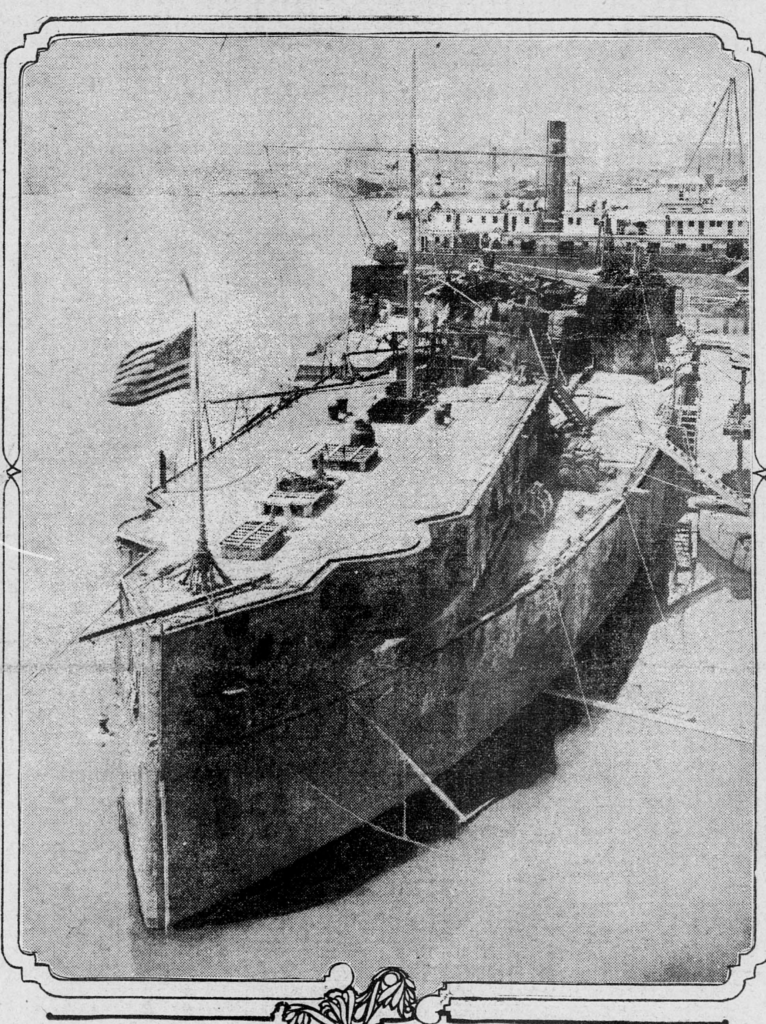
Later investigations in 1970 showed that the battleship had blown up from a natural build-up of gas causing the conditions for an internal combustion and a massive explosion. There was a highly charged content of American nationalist sentiment attached to the occasion of the funeral for the sailors and the towing of the vessel out to sea to be sunk in the deeps. Cecilia was publicly thanked by both the American navy and Government representatives as well as the Cuban Government now free of Spanish rule. There is film footage of parts of the occasion but none it seems of Cecilia singing.
But on the following day and while on her way to Antilla, and ultimately on her way back to England, she had been in a near fatal motor accident which left her in hospital with a shattered left leg and internal injuries. She was in severe pain for several months (120 days or seven months before she regained the use of her leg as reported and which would take her up to the October of 1912.) There is no report that anyone was with her at the time of the collision, and it might be presumed that she was driving alone. It seems that she had been thrown out of the car by the impact. As well as the horse of the two wheeled cart which had caused the crash falling upon her and crushing her chest, the thigh bone of her left leg had been severely broken, and though a surgeon at the Government hospital at Camaguey, the nearest town, was able to reset the bone, it refused to knit completely. There was grave danger of amputation and even loss of life.
It was at that time that Captain Albert Cushman Rice heard of the accident and the young woman was indeed, he discovered, the same who had voluntarily sung principal voice at the Requiem for the navy in Havana. He owned a plantation (other reports give it as a cattle ranch) nearby and, after visiting her set off for the naval base at Guantanamo. He went straight to Admiral Usher and asked for naval surgeons to see to the young woman. Though naval regulations would not allow its surgeons to treat a young civilian woman at the other side of the island, the Admiral got around the regulations by offering leave of absence to any surgeon who would want to volunteer to go to attend to her. Not unsurprisingly, every surgeon in the North Atlantic fleet stationed there, volunteered his services and from that number, four were chosen. It was now 101 days after the accident and Cecilia had lain in the hospital stoically accepting the pain. She hadn’t informed her parents, not wanting them to worry about her, and had only sent happy letters home to Blackpool. Her friends were not allowed to let them know either. All her parents knew of their daughter was that she was happy and enjoying life on the island. They would have been proud to view a recording of the service for the Maine in the Blackpool cinemas and their daughter in the best of health. There is silent film footage of the event but none has been located yet of the memorial service itself with Cecilia singing.
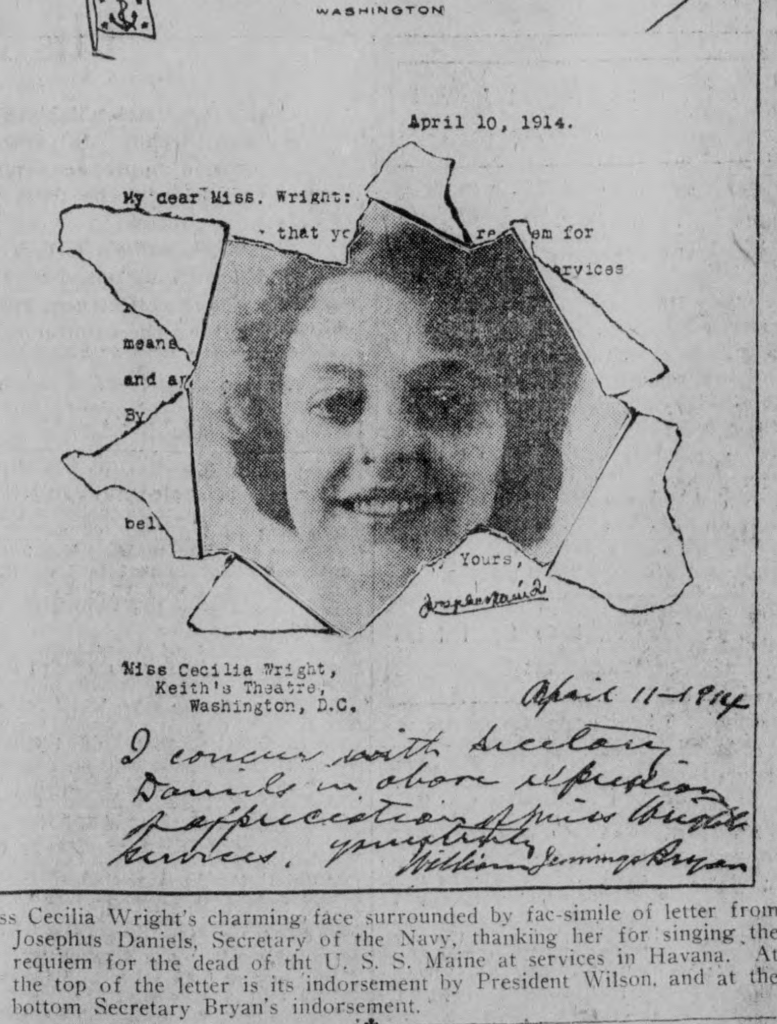
‘Miss Cecilia Wright’s charming face is surrounded by fac-simile of letter from Josephus Daniels, Secretary of the Navy, thanking her for singing the requiem for the dead of the U.S.S Maine at services in Havana. At the top of the letter is its indorsement by President Wilson and at the bottom, Secretary Bryan’s indorsement.’
From now on, assured of a heroine status to accompany the lure of her accepted beauty, she received the best medical attention which resulted in her eventual recovery from the brink of death and she had become a celebrity at that date and was the most talked about person in the USA. She had acquired the middle name of Manuela for an unknown reason, and the navy was very proud of her as their adopted daughter. After surgery a second swift operation to remove an ugly scar form her arm which she had covered continuously with a sleeve was successful. Her recuperation took place on Captain Rice’s Plantation but it was seven months before she got the use of her left leg. There were understandably rumours in the following years of her being engaged to Captain Rice but nothing substantiated. And it was at this ranch that she probably acquired, with the influence of Captain Cushman Rice, an interest in both sport and the thrill of aviation. Cushman Rice was the head of the National Sporting Club in Havana and was a leading figure in the ruling white society in which black and white were a great distance and a great age from being equally integrated into the same society.
Vaudeville
Up to this date she had performed on the more serious stage of the light opera of Gilbert and Sullivan but, once recovered, such was her popularity and the focus upon her name, that she was invited to join BF Keith’s vaudeville company at the Palace in New York, and for this reason, which must have been highly attractive to her, it is reported that had she deferred a trip home to visit her parents in Blackpool. It would be a new enterprise for her and indeed good money. She probably wouldn’t have been able to be back on stage by late 1912 or even early 1913. There are no direct reviews to date and much reporting is retrospective so her debut might refer to late 1913 or into 1914, but on her first night she was recalled for encores twice which was unusual for the normally impatient vaudeville audiences. A particular favourite was ‘Comin Through the Rye’ and she sang further songs in both English and French. The programme for Keiths Palace Theatre of 1914 proclaims, ‘this young woman is destined shortly to become one of vaudeville’s brightest lights’. Both the United States army and navy were well represented in the audience and probably influenced the encores. Cecilia’s was the most mentioned name in America by now, and busloads of navy personnel and high ranking naval officials from the various battleships in the city’s port, regiments of the National Guards and the Spanish War veterans, filled the theatre. It was the ‘clear sweet voice’ that had warmed the hearts of the navy in Cuba during the requiem of some of their comrades, ‘that will attract such attention in musical circles’.
Hard work but good pay was the rule in America especially in vaudeville with sometimes 14 performances a week which included a matinee and an evening performance and sometimes long distances across country of 17 hours between towns. Her own act consisted of fifteen minutes only so she was able to cope well. But you have to behave yourselves, she claims, which smacks of a strangulating management control over the performers.
It was while she was in Washington on this tour that she was invited to the White House to meet President Wilson who was a ‘most charming man’ and made her feel quite at home in his company. He was glad that she had not received a permanent injury to her accident and hoped that she would prosper in her profession. In front of the President, and Mr Daniels the Navy Secretary and William Bryan Secretary for War, she wooed them with Mandalay, a lullaby (berceuse) from Jocelyn and a medley of South American songs to demonstrate her versatility. Her name at the time continued to be the most spoken name in the country.
She is reported as being in vaudeville in England in July of 1914 though evidence is scanty and she may have been on a pre-arranged visit to her parents only as reported in the Fleetwood Express. She had certainly made a visit to her parents in Blackpool at that same time where she is interviewed at the family home and in which report she describes her meeting with President Wilson who had concurred with her description as an ‘adopted’ daughter of the USA. It was desired by all the navy staff that she should be the natural daughter of the navy but she declared her Englishness and that she could only ever be their ‘adopted’ daughter, just as the other vaudeville artist from Blackpool, Victoria Monks had always declared herself John Bull’s girl. Her nationalism, as a subject of King George, was respected and she thus had become the ‘adopted’ daughter of the US navy and was billed as such wherever she appeared in performance.
Her career continues on the stage, though still maintaining a status below that of a superstar but with enough status to be mentioned as one of the six most considered beautiful women in New York when selected for the Russian bazaar held at the time in 1914 and as the leading lady in the somewhat raunchy Ziegfield Follies as one of these six most beautiful girls. Where the female figure is for ever in the shop window, Florenz Ziegfield director of the Follies had married two of the performers at different times. It is not known how much Cecilia had to compromise, but nudity was expected of performers if required. There is a reference to Cecilia in the Theatre Magazine available at Google Books and the picture of her displayed reads, ‘Ziegfeld’s productions are wonderfully gowned. Here is Cecilia Wright wearing a beautiful lace draped dinner gown.’ The link to the page is at the end of this story.
Sport
When she had returned to England to visit her parents she had made the visit via Paris where she had taken in the heavyweight boxing match between Jack Johnson and Frank Moran in the June of 1914 which the reigning champion Johnson won. She made her name covering this fight and she would watch and report on a Jack Johnson fight again in Cuba in more controversial, as well as acutely more observational, surroundings. It was a curiosity for a woman to show a keen interesting in boxing and when asked why she was, she replied, ‘why not?’ and anyway boxing was more scientific these days consisting more of body shots than the facial blows that disfigured the face. You saw more brutality on the football field than in the boxing ring she claimed. In this instance she was probably talking about either American football or even English rugby football. And before she arrived in Blackpool she took in and reported upon the fight between Freddie Welsh and Willie Ritchie at the National Sporting Club in London, a fight which Freddie Welsh won over the American in a 20 round decision.
Her interest in sport, if not a natural interest from an early age, would certainly have been encouraged and strengthened by her recuperation at the plantation (or, in other reports, the cattle farm) of Captain Albert Cushman Rice. There would be rumours that the two would become engaged to marry though this seems to have been rumour alone. Whether anything romantic had developed at the farm or not, it perhaps could not be long lasting for two people with ultimately different directions in their lives though they did spend some months travelling the world together. If her interest in sport had been encouraged at this time it is reasonable to assume that her interest in flying originated from this point too, as Albert Cushman Rice was an aviator, a soldier of fortune and a big game hunter with a focus upon his name in society. As such he is suspected as being the influence for Scott Fitzgerald’s Great Gatsby and certainly for Captain Macklin, the character in the novel by Richard Harding Davis, friend of that other Cecilia with a Blackpool connection, Cecilia Loftus. As a contracted sports correspondent, and it might be understood, an occasional singer and dancer as well, Cecilia would soon tour the world with Captain Rice and, while in Australia, she had hoped to join in a kangaroo hunt which might reflect the influence of Cushman Rice in the days when hunting was acceptable to most, other than perhaps the indigenous populations whose effective symbiosis with the animals would become disrupted. Cecilia claimed to be a good shot so her intentions would have been on game hunting in its destructive sense, easily criticised today but at the time it was a claim of independence for a woman in an otherwise male domain and it does suggest a closeness of spirit at least between herself and her travelling companion even there was no committed romance or physical involvement.
Once back in America she began a long tour in vaudeville beginning in Pittsburgh, and she spent some time in the spring of this year in Washington as the guest of Mr Robbin, manager of Keiths and his wife. In this year of 1915 and after the Johnson-Willard fight, as the ‘queen of the vaudeville’ she was selected to report upon the world’s series of baseball in the USA, by the United State Press Association which covered 650 of the biggest afternoon papers in the USA and Canada, the first woman to be asked to do so such was her popularity and, no doubt, skills. For this she was considered as ‘proof of the marvellous development of women in this century.’ She would eventually write for most of the big American journals and magazines.
She is, while on this vaudeville tour at this time, at the highest level of fame, popularity and achievement and is lauded by the mayors and dignitaries in every town and city in which she appeared on stage. She is in Michigan in November of 1915 staying at Kalamazoo and Ann Arbo where she continued her interest in sport by attending a ‘university game’ which is presumably a football game. Her knowledge of boxing by 1915 was equal to none it would seem and she was certainly the most knowledgeable woman. In an interview for the Honolulu Star in December of 1915 in Waikiki she could talk confidently of the fights between Willard and Johnson, Gibbons and Clabby, Mc Goorty and Darcy in Sydney (which had taken place earlier in the year in July) and at this time she was expecting to attend the Willard-Fulton bout in New Orleans. Her correspondence work took her into the training camps of the boxers so her knowledge was first hand and she knew some of the boxers by first name terms. The McGoorty-Darcy fight was in Sydney and her knowledge of boxing in the subsequent article was accurate and incisive. Darcy, the Australian, won, becoming the boxing idol of Australia. She then regrets not being able to attend the meeting between Gibbons and Darcy which would indeed be a great fight.
Her rise to the notice of the sports papers and boxing fraternity, had come after she had covered the fight between Jack Johnson and Jess Willard in Havana on April 5th of 1915 and her feminine sentiment went out to the white wife of black Jack Johnson, rejected by family and friends for marrying an Afro-American, as she witnessed his defeat. Cecilia had been in Cuba at the time reportedly with a vaudeville ‘troupe’brought in by George Bradt, editor of the Havana Post and boxing promoter who had arranged for ‘a large vaudeville troupe’ to entertain at the venue before the boxing match. Though it doesn’t seem that there was a great deal of interest in this entertainment, the group included Cecilia Wright who happened to be a boxing fan and she convinced George Bradt to let her do a report on the matches scheduled for the stadium. It was a way for the newspaper editor to promote respectability for women to be enthusiastic about boxing and at the same time ‘should be encouraged to attend so that they could best understand how to educate the future generation of men.’ In this sentiment there is more of the radical feminine in Cecilia rather the quieter conservative woman who might otherwise shun controversy. It was Cecilia’s introduction to the boxing fraternity there and she stayed on the island to cover the fight after the vaudeville troupe had left. In this respect it seems that she was working freelance at the time and in doing so she became the first female to officially report on a world title fight. Matches between black and white were usually banned because of the very real potential for race riots and at this event, the Cuban army were on hand to deal with disturbances. Captain Cushman Rice had opposed the venue for the fight Cuba for just such a reason.
Tantalisingly there is film of the Johnson/Willard fight of April 5th 1915 in existence and displayed online but searching the audience in the grainy film there is nothing conclusive of a glimpse of Cecilia at the frantic ringside. There is evidence of at least one woman among the sea of white boaters worn by the men. But there is a still of Mrs Johnson in her isolation. The fight itself was alleged to have been thrown with Jack receiving $50,000 (on top of the $29,000 cut, to do so which was handed to his wife.) The fight, ending in the 26th round had been scheduled for 45 rounds but itwas evident that Willard, the younger, taller, stockier man had the fight in his hands anyway.
At the beginning of the fight when Jack Johnson noticed the female reporter in the press box he asked her to be removed because he didn’t want a woman to be witness to his language. Cecilia Wright known for her engagements at the New York theaters, obliged and moved further back while the crowds shouted Viva el Blanco! and the mood was a victory for white supremacy since Jack had held the title since 1908. The streets were afterwards lined with folk proclaiming the victory and at the outdoor race track where the fight had been conducted in 103° temperatures, the Cuban army having had to rush the ring with drawn sabres to protect both the boxers from the frenzy of the crowds and to prevent a race riot. White flags waved by the white folk and black flags waved by the black folk. Johnson had not been at his best and it took till the 26th round before he was beaten by a much younger and much cruder boxer, and a crowd that was against him. It was believed that Johnson had quit rather than take further punishment even though he had slumped to the floor, perhaps in doing so, feigning a real knockout. At the beginning of the 25th round Johnson perhaps knowing it was the end asked his corner to take his wife away because he didn’t want her to be a witness to his demise which he knew was imminent. His wife got up to leave, with or without the alleged $50k bribe for her husband to throw the fight arranged with the alleged undertones of racial pressures but did nevertheless in getting up to leave, witness his knockdown right in front of her and she could only exclaim, ‘Oh, my God,’ before making her way through the 18,000 crowd. Cecilia meanwhile had feminine sympathy for the wife and included words for her in her report. Signing herself as Cecilia Wright Keith, she describes the fight and turns her attention to Mrs Johnson, ‘I turned to the ringside boxes and saw the white girl who had bound her life to the black – exiled from her own family, her friends and her country. She is pretty, perhaps a little swagger because of familiarity with the boulevards of Paris and Buenos Aires but nevertheless she is a woman with the feelings of a woman. And in the crisis of her life, her own sex must reach out to her. I hold no brief for her actions in the past. I am only telling of her looks as her partner in life went into the conflict that was to change him into one of the heroes of the past.’ (The Santa Ana Daily Register April 8th 1915.) In the racial distinctions of the time Cecilia, at least was able to see the human being within the framework and the pure, colourless identity of femininity. Lucille Johnson, Jack’s wife had earlier shown she had a bit of fight in her when she herself had got into a hair pulling fight with a manicurist who had refused to treat her due to her marrying a black man.
But there was one sport that Cecilia kept away from and while in Australia she keeps away from cricket which she evidently doesn’t understand or doesn’t like… International cricket was of course suspended during the war years and Australians and New Zealanders were fighting and dying in the Dardanelles and in Europe. The first match between her home country and Australia would not be until 1919 between the military. The first Test Match between the two countries would include Australian fast bowler Ted MacDonald who would eventually settle in England, play both for Lancashire and Blackpool, and be the landlord of the Raikes Hotel in the town until his death in a road accident. His story is included elsewhere in this site.
This correspondence work for the United Press Association took her around the world and while in Sydney, Australia in the early days of WW1 she did not do any theatrical work but instead offered her services to any of the charitable and patriotic movements of her homeland and its outposts. Arriving first in Honolulu having sailed from San Francisco on the Sonoma it was only the first staging post on a tour which would take in, after three months in Australia, Japan, China, Indian and South Africa before returning to Europe and to England and home in Blackpool, if the war conditions permitted her to travel that way. In fact she was three months in Australia where she was accompanied by Captain Albert Cushman Rice and she wanted to see exotic and far flung places like Java and the American outposts in Indonesia, ultimately intending to arrive in Blackpool, England to see her parents who she hadn’t seen for several years. While she was travelling on the Sonoria which docked at Waikiki she couldn’t wait to get off to see the sights and witness the famous beach, the canoes and the surfing. Much of the day was taken up in this way and lunch was at the Moana hotel. While on the Sonoria she was visited by the patriotic Daughters of America no doubt attracted there by her renown as an adopted daughter of the American navy.
FLIGHT
It is reported in the June of 1915 that Cecelia Wright had survived the severe tornado that had struck the district of Highmore South Dakota, but without reference to the other Cecilia Wright describes her as a cousin to Wilbur Wright, and in all things aerial there is a short inclusion on the same page of the first time an aeroplane had sunk a submarine when German planes had attacked a Russian submarine in the Baltic Sea. Whether the Wright brothers had a cousin Cecelia or not, soon Cecilia Wright, sports correspondent, vaudeville star and opera singer, would take to the air herself. It was also reported on the same American newspaper page, with its Blackpool connection and which would have been an interest to her parents that the infamous serial killer Smith, had murdered his wife Alice Burnham in a bath tub in Blackpool. He had similarly killed another wife at an address in London once occupied by that other intrepid female balloonist in the days before aeroplanes, Alma Beaumont. Perhaps Cecilia would have been shocked to hear of the event that would have been a topic of both alarm and curious interest for her parents. But in reality the Cecilia Wright who wasn’t related to Orville or Wilbur, had left San Francisco for a tour of the world for the United Press, arriving first in Honolulu and then by August, reaching Australia. But it brings the story of Cecilia Wright into the world of heavier than air machines and achieving fame in another aspect her life.
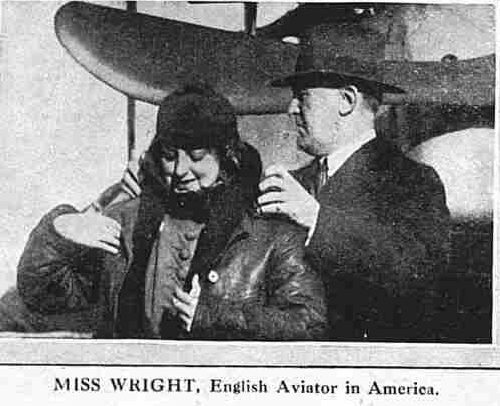
On the occasion of reaching 5100 feet and remaining in the air for nearly an hour and being celebrated for the feat.
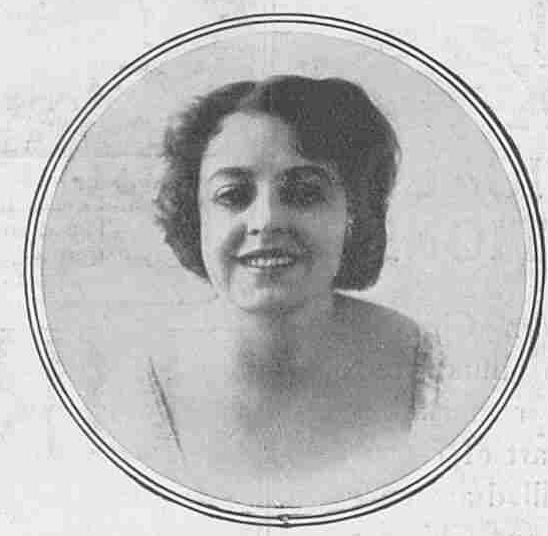
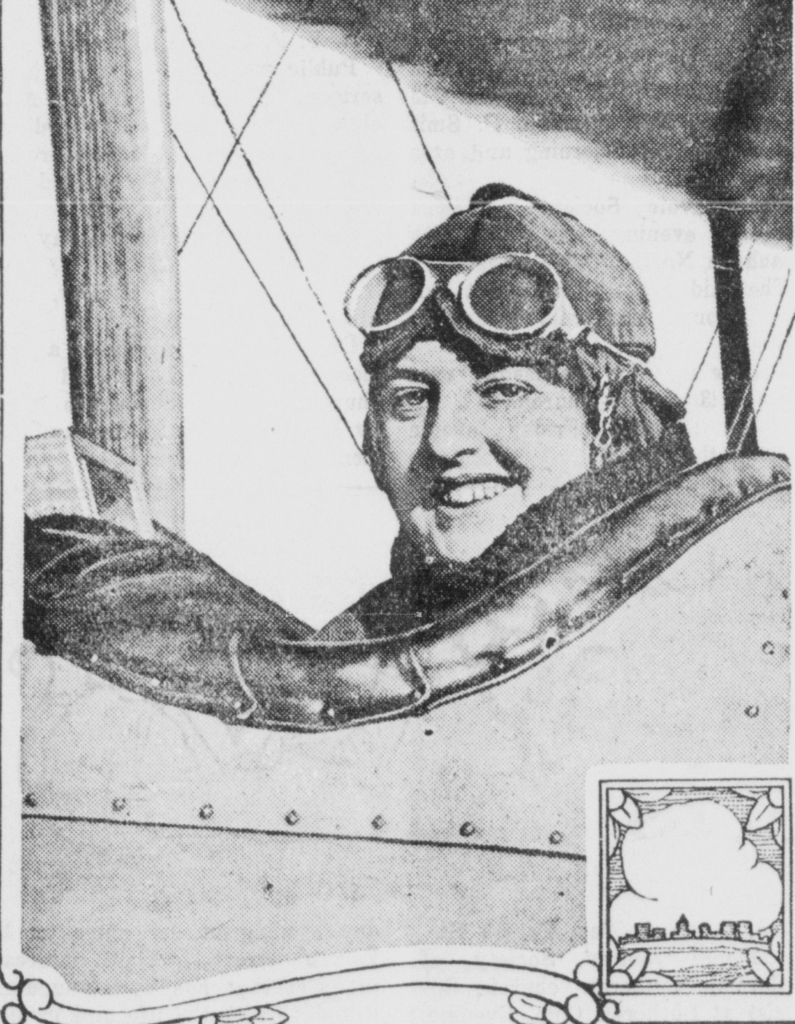
The caption Reads ‘Miss Cecilia Wright makes a successful flight to test the first government machine to be constructed as provided for in the $13,000,000 appropriation for aerial armament.
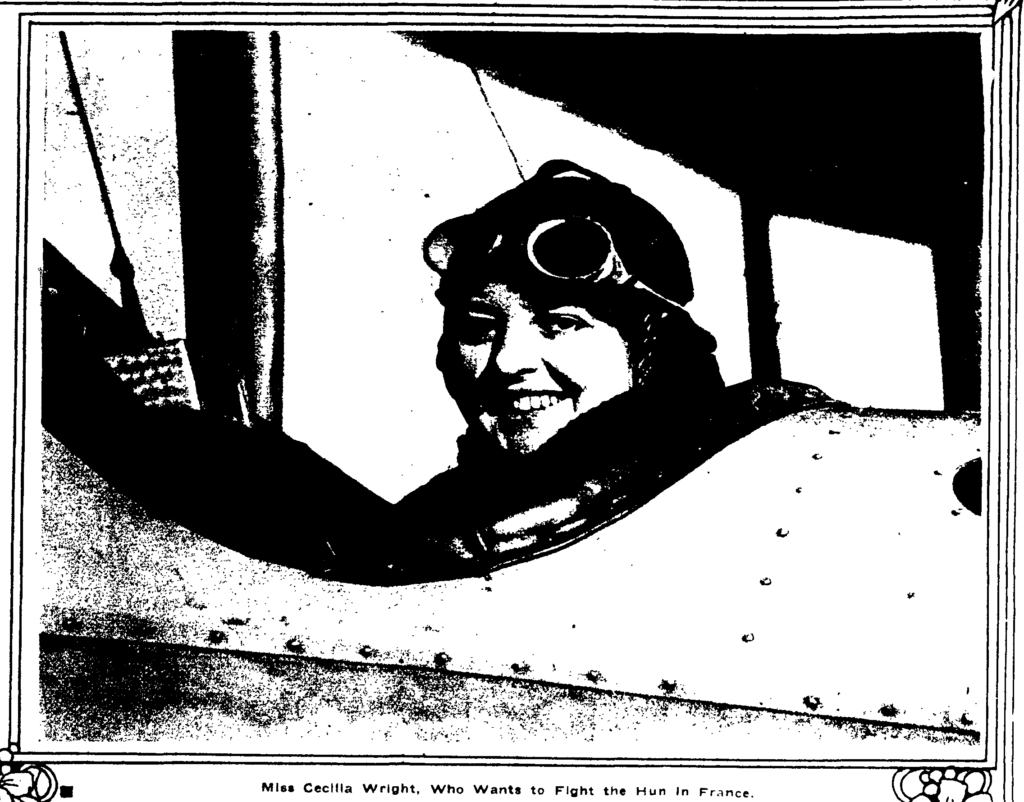
War sentiments and probably a bit of wishful thinking embellished by the press but she probably would have done if she could have done especially with the influence of aviator and war time pilot friend Albert Cushman Rice to encourage her. In the newspaper she is pictured alongside Katherine Stimson another, ‘daring young aviatrix.’ Her younger brother Charles, who returned to work at Whittingham Hospital, was fighting with the RGA with the rank of gunner in France during the War. He survived the war, his home address with wife Beulah is 8 Beacon Grove Fulwood, Preston.
However, rather than being the pilot, she would have been a passenger and Tex Millman the pilot as he is sat in the rear. Reaching an altitude record for a woman flyer of 5,100 feet and remaining 52 minutes in the air setting off from Mineola aviation field, New York, she achieved the feat under unfavourable weather conditions. Peter ‘Tex’ Millman chief army aviation instructor claimed that the weather conditions were the worse he had ever encountered as the aircraft dropped swiftly from 5,100 to 3,500 feet. It was the first test flight for the new design of American Government specification aeroplanes which were backed by $413m investment. The aeroplane was equipped with a 135hp Hall-Scott American made motor. It is the war years in Europe and though America is not yet in the war, Cecilia nevertheless busies herself continuously with the many efforts in the country to provide funds for the Allies, as did that other Cecilia with her Blackpool connection, Cecilia Loftus.
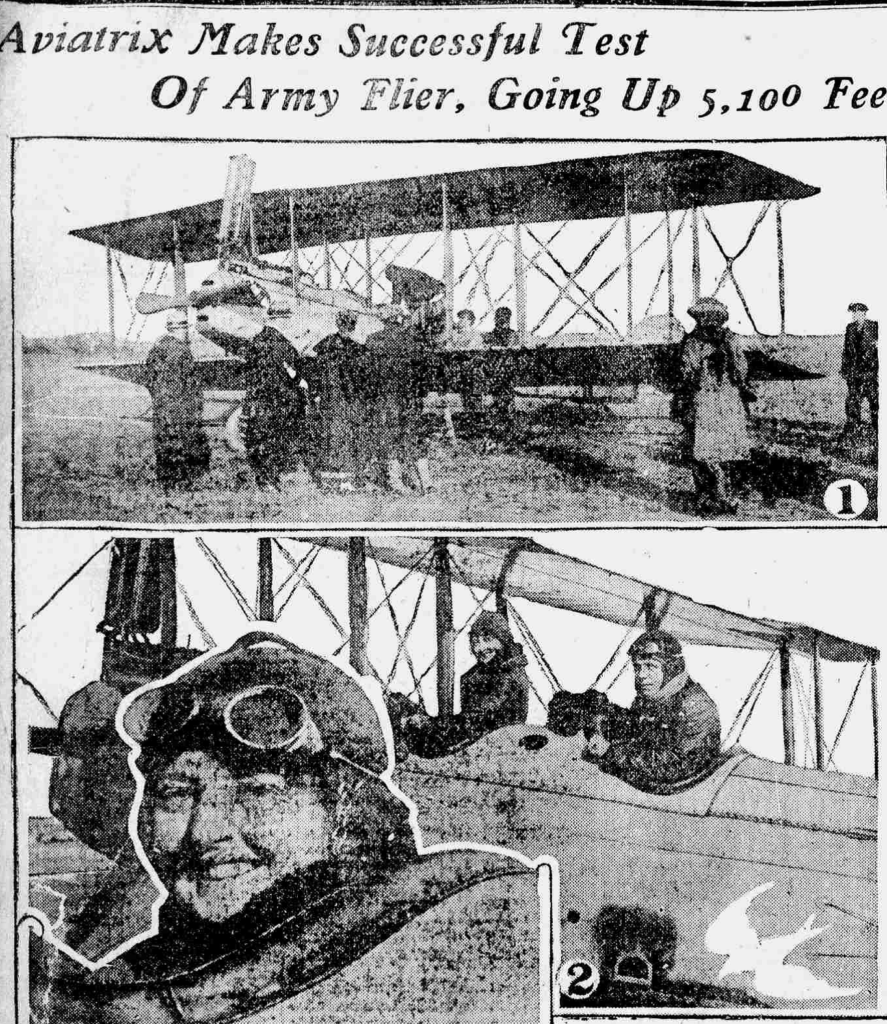
The captions show 1; Cecilia Wright entering the aeroplane, 2; With Tex Millman, 3; Close up. Captain Cushman Rice, (now reported as retired) was an observer among about 4,000 watching from the ground, and had been impressed with the new machine.
Her career on the stage continues and she was at BF Keiths in Boston in January of 1917 but doesn’t get a great mention in the paper, (Boston Sunday Post) nor a picture out of many actors and actresses on the page given the honour of a picture. Later in January in the newspaper gossip of the South Bend News she is recorded as visiting her friend Martha Decker and others in Grand Rapids.
In July she is engaged by Henry Savage to play a prima donna role in the Southern company in ‘Have a Heart’. It opens later in New York to good reviews and continues with full houses before going on tour. The two grainy pictures below are taken from the tour.
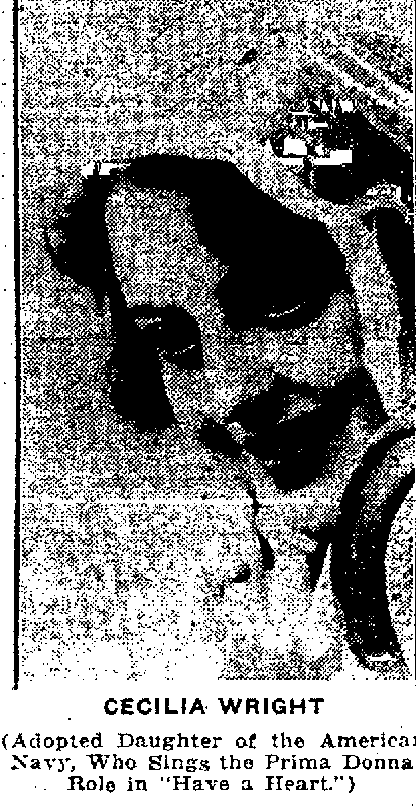
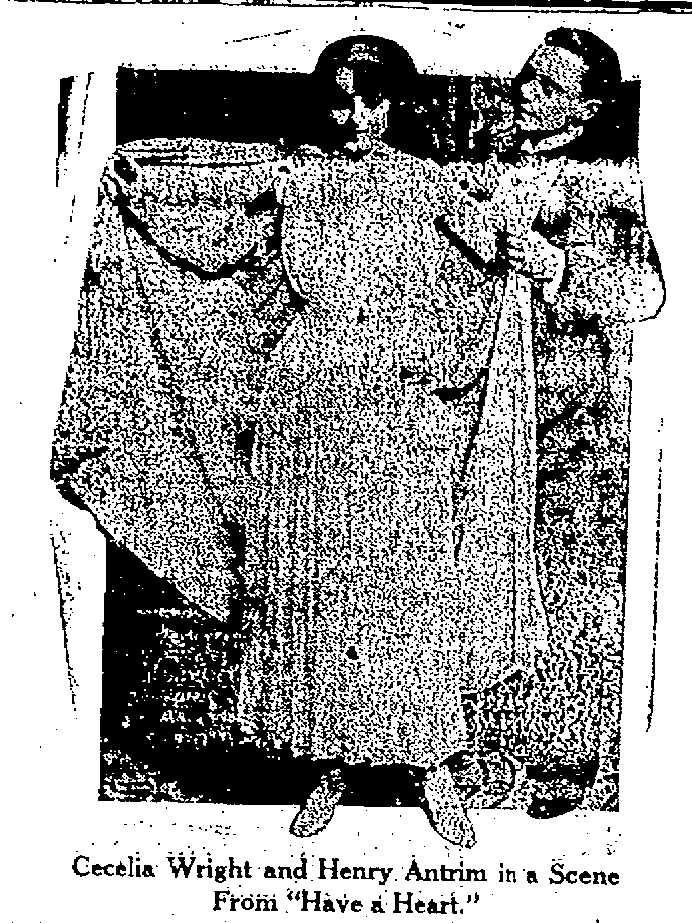
In 1918 we find her in Oklahoma continuing as leading lady of the ‘Have a Heart Company’ at the Overholser theater in the city and as reported she is now Mrs Thomas H Woods having made her home in the city some years ago and was prominent in musical circles and had been a soprano at the Methodist church choir. It is not established when or where or even whether she had indeed married a Mr Thomas H Woods. In January she is at Cedar Rapids and still with the ‘Have a Heart company’ which played through more than seventy performances which was considered a short run when other productions including some of the same writers and producers went on into the hundreds. ‘It is not a show with lasting qualities but for the present purposes of providing a light form of entertainment it is highly satisfactory.’ (Canton Daily News March 1st 1918). It was a situational comedy musical with a large amount of dancing in it. Cecelia Wright was singled out as the best of the singers in a large cast of females and a large number of original songs with catchy tunes and music. With a producer, William Savage and lyrics co-written by PG Wodehouse it was described as ‘a typical Savage musical, girly spectacle with big chorus, special orchestra and a world of clean fun.’ (Fort Wayne News February 2nd 1918.)

‘Cecelia Wright and the Pretty Fashion Shoppers in ‘Have a Heart’ at Greene’s Thursday Night.’ (Greene’s opera House in the city.)
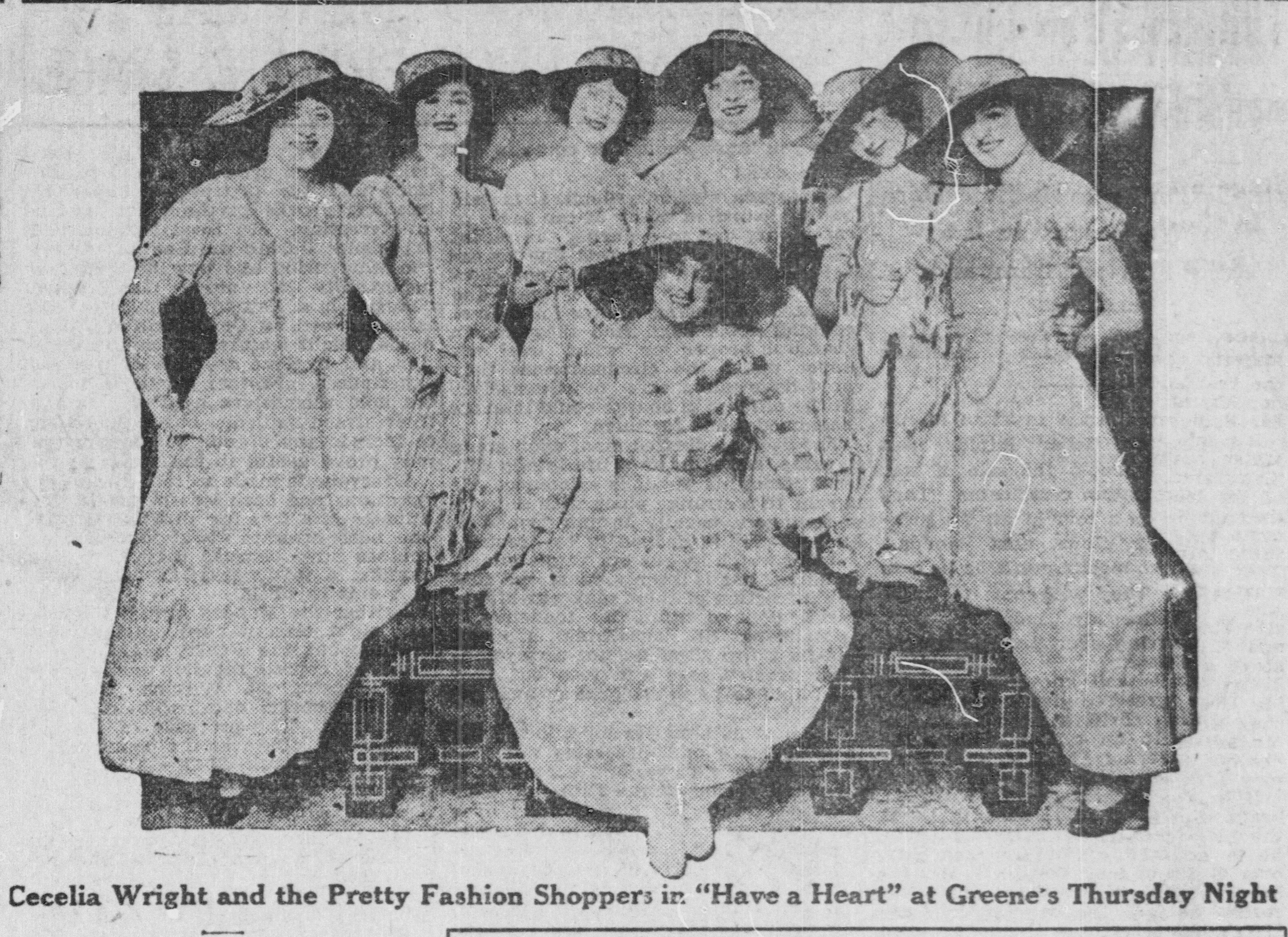
‘Cecelia Wright and the Pretty Fashion Shoppers in ‘Have a Heart’ at Greene’s Thursday Night.’ (Greene’s opera House in the city.)
Her life now has taken a quieter route in which perhaps fame is second to the life style she was leading then. Perhaps she was married and was content and the association with Cushman Rice had faded, but from now on the limelight does not expose her by choice or by circumstance. She is no longer in the news or on the lips of everyone as the adopted daughter of the US navy. The next we hear of her is in June of 1919 when she is briefly recorded as entertaining at the Roanoke Social Club at Blue Ridge Springs at a dance evening included jazz and other musical selections. It seems now that she has sporadic engagements on the stage or private entertainments.
In 1922 in McCloughlin Hall Oregon City a musical fairy drama was presented in which the vocals of Cecilia Wright as Verna, the fairy of Spring were featured. And she also turns up in Berkeley Recreation Department in 1938 in an entertainments programme which though primarily focussed on dolls, also included speciality Russian folk dancing by Cecilia.
From here Cecilia disappears, at least for the time being…..
Evening Post New Zealand 15/7/15bwith thanks to:- https://paperspast.natlib.govt.nz/newspapers/EP19150715.2.13
Miss Cecilia Wright the young Anglo-American sporting writer is a very interesting personality and is proof of the marvellous development of women in this century. She is touring Australia under engagement to supply sporting stories for the United States Press Association. Miss Wright is an English girl, a daughter of a conservative Blackpool family and was one time prima donna of the Gilbert and Sullivan Opera Company in London, scoring a great success as Elsie Maynard in the Yeoman of the Guard. In America she entered vaudeville and was a great favourite. She has written for most of the big American journals and magazines and made her first great success with her report of the Johnson-Moran fight in Paris last year which she followed up with a story of ‘human interest’ describing the feeling of Jack Johnson’s white wife when her husband was beaten. Miss Wright was interested in sport from her earliest days and when she arrived in Australia, expressed a wish that she might join in a kangaroo hunt, as she is a good shot. She is not going to do any theatrical work in Australia but as she is an ardent pro-Ally she has offered her services to any of the patriotic and charitable movements during her stay in Sydney.
Sources;
https://www.atticpaper.com/proddetail.php?prod=1914-keiths-palace-theatre-vaudeville-program
https://www.americanheritage.com/second-sinking-maine-0#5
https://www.bankofengland.co.uk/monetary-policy/inflation/inflation-calculator
https://idnc.library.illinois.edu/?a=d&d=NYC19140418.2.96&e=——-en-20–1–img-txIN———-
Theatre Magazine – Google Books
#346 – Theatre magazine. v.19 1914. – Full View | HathiTrust Digital Library
#346 – Theatre magazine. v.19 1914. – Full View | HathiTrust Digital Library



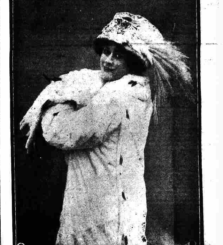
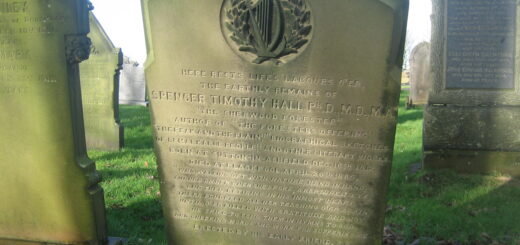
cecilia wright was a cousin of my daughter, several times removed. it is well documented in the family, and her father has some original documents regarding cecilia. my daughter now lives in the USA and has recently become an American citizen. there are remarkable similarities between her and cecilia. all the infirmation published about cecilia’s life is truly remarkable, little was known about her by the family, except the photos and the recorded event of her meeting woodrow wilson, and her awesome aviation feat. astonishing !!
Thanks for your comment and I’m glad Cecilia has found some relatives as you have been able to recognise and connect with her. It is evident that Cecilia was quite a remarkable person.
Thank you SO much for this! I’m a bit mind blown. Cecelia was always a family myth, we didn’t know much about her at all. Just one old newspaper clipping.
My grandma (my Dad’s Mum), was Barbara Cragg, a relative of Alice, and or Mary, I’ll have to do more research and find out their exact relationship. I believe Alice was either her aunt or possible cousin?
I’ve let my Dad and his cousins Jonathan and Bernard know about this article, they’ll be thrilled.
Unfortunately I don’t have any further information in an give you! I wish I did.
I’ve looked on line for her before, and was so happy to find this last night when I looked again.
Thanks for your comment. I’m glad you have been able to make a connection and that Cecilia has relatives. According to the census returns Mary Cragg, appear to be Alice’s sister, ad so would be Cecilia’s aunty. I thought there may be a connection through Cecilia’s brother Charles (who married Beulah, it appears) and lived in Preston and served in the Royal Garrison Artillery during WW1. My remit didn’t go further to find if they had children. I hope you can find the information you need to fill the gaps in your connection to Cecilia. I can send the census returns via email if you wish. Kind regards. Colin Reed
Charles Leonard Wright ( he used Leonard) was my grandfather
Cissy, as she was known in the family was his sister.
Strangely Cissy wasn’t talked about much in the family, I suspect she was regarded as a bit “naughty “ at the time,.
I’ve never been able to find out where or when she died other than my father ( born 1922) could just about remember her
It was said that she died in a hotel somewhere, although she is recorded on the family grave in Preston
I’m glad there is a connection with Cissy through her brother. It’s interesting that you say Cecilia returned to the UK I wonder if Cecilia is recorded in her possible married name of Woods at the death
Charles Leonard Wright, Cecilia’s sister was my Grandfather, so Cissy, as she was known in the family, was my great Aunt.
Despite her being so famous in the US remarkably little is know about her after her return to England and she didn’t seem to be talked about much. I’ve not been able to find out how or where she died other than it was in the 1920s and she is recorded on the family grave in Preston UK.
She seemed quite remarkable and deserved of more note in history than she has.